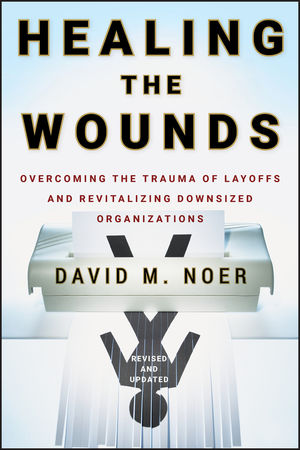Healing the Wounds: Overcoming the Trauma of Layoffs and Revitalizing Downsized Organizations, Revised & UpdatedISBN: 978-0-470-50015-6
Hardcover
272 pages
August 2009, Jossey-Bass
 This is a Print-on-Demand title. It will be printed specifically to fill your order. Please allow an additional 10-15 days delivery time. The book is not returnable.
|
||||||
Preface xi
Part One The Shattered Covenant 1
1 Forgotten Survivors: What Happens to Those Who Are Left Behind 3
Lessons from Act One: Juanita and Charles—Victim and Survivor 4
The Basic Bind: Lean and Mean Leads to Sad and Angry 6
Metaphor of the Surviving Children 7
Acts One and Two: A Family Legacy 10
Issues to Be Explored 11
Definitions 13
Learnings and Implications 15
2 Changing Organizations and the End of Job Security 17
From Assets to Costs: The New View of Employees 19
From Nurturing to Violence: The Symbolism of Layoff Language 24
From Long Term to Short Term: The Shrinking Planning Horizon 26
From Synergistic to Reductionistic: Taking Apart is Better Than Putting Together 27
Layoff Survivor Sickness: The Legacy 28
Learnings and Implications 29
Part Two The Survivor Experience 31
3 Learning from the Past: The Survivor Syndrome Across Time 33
The Saga of “No Toes,” the Gunslinger 34
Universal Survivor Linkages 37
Lifton’s Model of Hiroshima Atomic Bomb Survivors 40
Learnings and Implications 45
4 Speaking for Themselves: Layoff Survivor Stories 47
Organizational Characteristics 48
Research Methodology 48
Job Insecurity 49
Unfairness 49
Depression, Stress, and Fatigue 50
Reduced Risk Taking and Motivation 51
Distrust and Betrayal 52
Optimism 52
Continuing Commitment 53
Lack of Reciprocal Commitment 53
Wanting It to Be Over 54
Dissatisfaction with Planning and Communication 55
Anger over the Layoff Process 56
Lack of Strategic Direction 57
Lack of Management Credibility 58
Short-Term Profit Orientation 58
Sense of Permanent Change 59
Unexpected Findings 60
Learnings and Implications 62
5 Time Does Not Heal All Wounds: The Effects of Long-Term Survivor Sickness 63
Stress, Fatigue, Extra Workload, Decreased Motivation, Sadness, and Depression 64
Insecurity, Anxiety, and Fear 65
Loyalty to Job (Not Company), Nonreciprocal Loyalty, and Self-Reliance 66
Sense of Unfairness and Anger over Top Management Pay and Severance 67
Resignation and Numbness 67
Lack of Management Communication 68
Helpful and Communicative Managers 69
Honest Communication 70
Short-Term Plans and Strategy 70
Layoff Process Problems 71
Resentment over Being Made to Feel Guilty 72
A Look Back from the Second Act 73
Learnings and Implications 74
Part Three Interventions For Healthy Survival 75
6 A Four-Level Process for Handling Layoffs and Their Effects 77
Layoff Survivor Feeling Clusters and Coping Strategies 79
The Four-Level Intervention Model 82
Learnings and Implications 84
7 Level One: Manage the Layoff Processes 85
“Clean Kills” and the Survivor Hygiene Factor 86
Redundant Communication is Essential 86
What to Communicate 87
Control Traps That Block Communication 88
Balancing Feeling and Thinking 92
Tell the Truth, and Never Say Never 97
Two Denial Traps 100
Process Research 103
Learnings and Implications 106
8 Level Two: Facilitate the Necessary Grieving 109
The Burden of a Heavy Bag 111
A Team Intervention 113
An Attempted Systemwide Intervention 115
A Small Business Visioning Intervention 118
A Departmental Wake 121
Empowering Leaders Through Models of Change 123
Learnings and Implications 126
9 Level Three: Break the Codependency Chain and Empower People 129
Dagwood’s Prescient Stand 130
Codependent Relationships 131
Organizational Codependency 131
Detachment 133
Letting Go 138
Connecting with a Core Purpose 144
Learnings and Implications 148
10 Level Four: Build a New Employment Relationship 151
The Global Context of the New Reality 154
From Long-Term to Situational Employment Relationships 155
From Rewarding Performance with Promotion to Rewarding Performance with Acknowledgment of Relevance 158
From Paternalistic to Empowering Management Behavior 161
From Toxic Fidelity to Healthy Self-Responsibility 165
From an Implicit Career Covenant to an Explicit Job Contract 169
Elements of Explicit Contractual Relationships 175
Learnings and Implications 176
Part Four The Leadership Wake-Up Call 179
11 Requisite Leadership Competencies They Don’t Teach in Business School 181
Choose the Right Wolf to Feed 182
Avoid Layoff Leadership Traps 184
Behave Courageously 186
Let Go of Outdated Managerial Commandments 188
Don’t Listen to Chicken Little 192
Learnings and Implications 195
12 Rethinking Loyalty, Commitment, and Motivation: The Long and Painful Birth of the New Reality 197
Ten Old Paradigm Commandments Reframed 198
Putting the Pieces Back Together: Reintegrating the Busted Culture 202
Learnings and Implications 205
13 Developing the Right Leadership Stuff 207
Developing Philosopher-Kings: Learning from Plato 207
Intrapersonal Insight 208
Interpersonal Competence 211
Core Skills and Relevant Models 213
The Global Context of New Paradigm Leadership 219
Learnings and Implications 223
14 Life After Downsizing: Revitalizing Ourselves and Our Organizations 225
The Top Ten New Reality Managerial and Employee Roles 225
Fragile Choices 231
The Existential Act of Choosing Freedom 235
Learnings and Implications 236
References 237
Acknowledgments 241
The Author 243
Index 245



